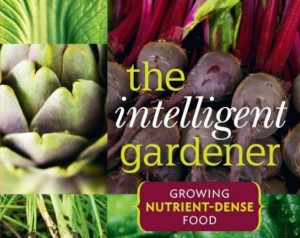Steve Solomon is a knowledgeable gardener. He has written several garden books, and started the Territorial Seed Company in 1979 when he was 37 years old. Seven years later, he sold the business but he continues to garden and grow a large portion of the food he eats. He has been growing most of his family’s food for over 35 years.
Many years ago, he formulated a recipe for a wonderful organic fertilizer. The recipe used to be in the Territorial Seed Catalog before they began mixing and selling their own fertilizer. It is good for all plants, and will make you plants thrive. One should apply 4-6 quarts of this fertilizer per 100 square feet.
I’ve used this recipe for many years.
Complete Organic Fertilizer (COF) Recipe
Mix uniformly, in parts by volume:
4 parts seed meal
1/4 part ordinary agricultural lime, best finely ground
1/4 part gypsum (or double the agricultural lime)
1/2 part dolomite lime
Plus, for best results:
1 part bone meal, rock phosphate or high-phosphate guano
1/2 to 1 part kelp meal (or 1 part basalt dust)
If you’re concerned about the amount of lime in this recipe (as I was) read Mr. Solomon’s explanation below. I’ve read forums that discuss this recipe, and experts agree with what he says here.
“You may have read that the acidity or pH of soil should be corrected by liming. I suggest that you forget about pH. Liming to adjust soil pH may be useful in large-scale farming, but is not of concern in an organic garden. In fact, the whole concept of soil pH is controversial. ”
Steve Solomon’s New Advice
In Steve Solomon’s latest book The Intelligent Gardener: Growing Nutrient Dense Food he has updated his COF recipe to include many more ingredients and options, but he has also provided an easy option on page 82. “Down To Earth in Eugene, Oregon began manufacturing a range of complete organic fertilizers. Someone doing this commercially has advantages over the home gardener; they can include ingredients only obtainable by the ton in bulk, so they can build a more complex mixture that releases some nutrients rapidly and others gradually, over a longer period. DTE’s fertilizer blends are approved for organics.”
Click here for a source for Down To Earth fertilizer.
In this latest book, he has also transformed from an expert “organic” gardener to an expert “nutrient dense” gardener. The concept of nutrient dense food is pretty simple. Plants contain nutrients derived from the soil, so if the soil is low in nutrients so are your vegetables. The gardener works over time to balance the soil with the proper mix of minerals. The result will be an environment that encourages the soil life forms (worms, bacteria, etc.) to create soil that will grow healthier plants that are also more resistant to pests.
Below is the COF recipe included in Steve’s new book:
To make enough complete organic fertilizer to generously cover 100 square feet, mix:
3 quarts oil seed meal such as soybean meal, cottonseed meal or canola seed meal or 1 1/2 quarts feather meal or fish meal (smelly)
or, the very best combination is probably 2 quarts oil seed meal, 1 pint feather meal and 1 pint fish meal
Add:
-
1 quart soft or colloidal rock phosphate (the best choice by far) or bone meal
-
1 quart kelp meal and/or 1 pint Azomite (for trace minerals) (And/or apply liquid kelp every 2 weeks as a foliar throughout the season.)
Add lime: choose one of these two options:
-
If you garden where the land originally grew a forest, add these two:
-
1 pint agricultural limestone, 100# (fine grind) and
-
1 pint agricultural gypsum;
or if you garden where the land originally grew prairie grass or is a desert add:
-
1 quart agricultural gypsum
If you do not live in Cascadia, add 1/3 cup potassium sulfate.
The following last four items are optional:
-
1 teaspoon laundry borax or a smaller quantity of Solubor (1/2 gm actual boron)
-
1 1/2 teaspoons zinc sulfate
-
2 teaspoons manganese sulfate
-
1 teaspoon copper sulfate



